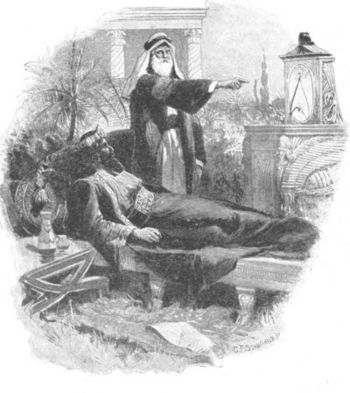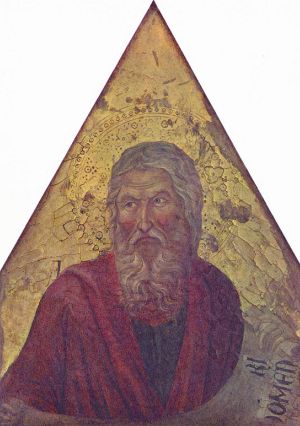Isaiah
Isaiah or Yeshayáhu (יְשַׁעְיָהוּ "Salvation of/is the Lord", Standard Hebrew Yəšaʿyáhu, one of the greatest prophets of the Hebrew Bible.
In his long career, he advised several of the Kings of Judah. He warned Israel and Judah of impending doom as a punishment from God for His people's sin. As court prophet to Judah's King Hezekiah, the Bible reports that he converted that king from a sickly compromiser to a faithful leader who — with God's miraculous help — successfully turned back the rampaging armies of Assyria that had ravaged the entire nation save Jerusalem itself. As the purported author of the Book of Isaiah, he is credited with having written some of the most memorable lines in literature, especially those predicting the coming of the Messianic Kingdom of universal peace. (Isaiah 9,11,60) In Christian tradition, Isaiah's prophecies of the Suffering Servant are seen as foreseeing the crucifixion of Jesus, although this interpretation is not shared by Jews. The New Testament indicates that the Book of Isaiah was influential on both John the Baptist and Jesus.
The details of the history of Isaiah's life are much debated by scholars, as is the question of which sections of the Book of Isaiah actually record prophecies made by him and which sections reflect later oracles penned by writers who took inspiration from him.
Biography
Reprotedly of a cousin of the Judean King Uzziah, Isaiah was the son of Amoz, not to be confused with the northern prophet Amos, whose oracles do seem to have influenced Isaiah considerable. His first call to the prophetical office is not recorded. A second call came to him "in the year that King Uzziah died" (Isa. 6:1).
I heard the voice of the Lord saying, "Whom shall I send? And who will go for us?" And I said, "Here am I. Send me!" He said, "Go and tell this people: " 'Be ever hearing, but never understanding; be ever seeing, but never perceiving.' Make the heart of this people calloused; make their ears dull and close their eyes. Otherwise they might see with their eyes, hear with their ears, understand with their hearts, and turn and be healed."
Then I said, "For how long, O Lord?" And he answered: "Until the cities lie ruined and without inhabitant, until the houses are left deserted and the fields ruined and ravaged, until the Lord has sent everyone far away and the land is utterly forsaken.
He exercised his ministry in a spirit of uncompromising firmness and boldness in regard to all that bore on the interests of religion. He conceals nothing and keeps nothing back from fear of man. He was also noted for his spirituality and for his deep-toned reverence toward "the holy One of Israel." Isaiah and Micah were contemporaries (see Isa. 1:1 and Micah 1:1). They concentrated their prophecies mainly on Judah and Jerusalem (Isa. 1:1). Amos and Hosea preceded Isaiah (Amos 1:1; Hosea 1:1) and they prophesied mainly against the Northern tribes of Israel.
In early youth Isaiah must have been moved by the invasion of Israel by the Assyrian monarch Tiglath-Pileser III (2 Kings 15:19). Later, Ahaz, king of Judah, refused to co-operate with the kings of Israel and Syria in opposition to the Assyrians, and was on that account attacked and defeated by Rezin of Damascus together with King Pekah of Israel (2 Kings 16:5; 2 Chronicles 28:5, 6). Ahaz, the allied his nation with Assyria against Israel and Syria. The consequence was that Rezin and Pekah were conquered and many of the people carried captive to Assyria (2 Kings 15:29; 16:9; 1 Chronicles 5:26).
His ease of access to the king and other leaders (ref. Isa. 7:3; 8:2), together with sources which tell us that Isaiah was the cousin of King Uzziah and therefore of royal lineage, suggests he was of a family of high rank.
Isaiah was married to a woman referred to as "the prophetess" (8:3). Why she is called this is disputed. Some believe she may have carried out a prophetic ministry in her own right. Others maintain that it was simply because she was the wife of "the prophet," and not because she was herself endowed with the prophetic gift. Isaiah had by her two sons, who bore symbolic names (Isa. 8:18) - Shear-jashub, 'Remnant will return' or '[Only] a remnant will return' (7:3) and Maher-shalal-hash-baz, 'To speed the spoil he hasteneth the prey' or, 'Destruction is imminent'(8:1-4). Amoz, He exercised the functions of his office during the reigns of Uzziah (or Azariah), Jotham, Ahaz, and Hezekiah (1:1), the kings of Judah. Uzziah reigned fifty-two years in the middle of the 8th century B.C.E., and Isaiah must have begun his career a few years before Uzziah's death, probably in the 740s B.C.E. He lived till the fourteenth year of Hezekiah, and in all likelihood outlived that monarch (who died 698 B.C.E.), and may have been contemporary for some years with Manasseh. Thus Isaiah may have prophesied for the long period of at least sixty-four years.
Soon after this Shalmaneser V determined wholly to subdue the kingdom of Israel, Samaria was taken and destroyed (722 B.C.E.). So long as Ahaz reigned, the kingdom of Judah was unmolested by the Assyrian power; but on his accession to the throne, Hezekiah, who was encouraged by Isaiah to rebel "against the king of Assyria" (2 Kings 18:7), entered into an alliance with the king of Egypt (Isa. 30:2-4). This led the king of Assyria to threaten the king of Judah, and at length to invade the land. Sennacherib (701 B.C.E.) led a powerful army into Judah. Hezekiah was reduced to despair, and submitted to the Assyrians (2 Kings 18:14-16). But after a brief interval war broke out again, and again Sennacherib led an army into Judah, one detachment of which threatened Jerusalem (Isa. 36:2-22; 37:8). Isaiah on that occasion encouraged Hezekiah to resist the Assyrians (37:1-7), whereupon Sennacherib sent a threatening letter to Hezekiah, which he "spread before the Lord" (37:14). According to the account in Kings (and its derivative account in Chronicles) the judgement of God now fell on the Assyrian army. "Like Xerxes in Greece, Sennacherib never recovered from the shock of the disaster in Judah. He made no more expeditions against either southern Palestine or Egypt."
The remaining years of Hezekiah's reign were peaceful (2 Chr. 32:23, 27-29). Isaiah probably lived to its close, and possibly into the reign of Manasseh, but the time and manner of his death are not specified in either the Bible or recorded history. There is a tradition that he suffered martyrdom in the pagan reaction in the time of Manasseh. Both Jewish and Christian traditions state that he was killed by being sawed in half. Some interpreters believe that this is what is referred to by Hebrews 11:37 (in the New Testament), which states that some prophets were "sawn in two". It is also mentioned in the book of The Martyrdom of Isaiah that he lived into the days of Manasseh, and was also sawn in half with a wooden saw.
Second Isaiah, or Deutero-Isaiah, is the title given to the writings that comprise a major part of the Book of Isaiah. Either as an individual or a collective body of prophetic writings later collected into a single volume, Deutero-Isaiah is thought to have been written during the period of exile in Babylon in the sixth century b.c.e.. It includes the great messianic prophecy of Isaiah 60 as well as the Servant Songs concerning Israel's suffering and redemption. These hymns, especially Isaiah 52-53, were later interpreted by Christians to refer to Jesus rather than to the Jews as a people. A "Third Isaiah" is also posited, referring to writings incorporated into the Book of Isaiah from post-exilic times. Some evangelical scholars, it should be noted, deny the thesis of "two Isaiahs," insisting that virtually the entire Book of Isaiah, except for a few narrative sections, is the work of the historical Isaiah of Jerusalem.
==Critical scholarship==
The noticeable break between the first part of Isaiah (Is. 1-39) versus the latter half of the book (Is. 40-66) caught the eye of eighteenth century critical scholars Doderlein (1789) and Eichhorn (1783), who advocated a source-critical reading of the book, seeing chapters 40-66 as later, post-exilic additions, or even totally separate works artificially appended to the earlier composition. The term "Deutero-Isaiah" described the anonymous later writer, to whom some ascribed some redactionary roles as well. Some more recent commentators have further divided 40-66 by adding a third Isaiah, Trito-Isaiah, who wrote 56-66. The provenance of the text in the latter half of the book seemed to support a post-exilic timeframe, with direct references to Cyrus, King of Persia (44:28; 45:1, 13), a lament for the ruined temple, and other details. Also, the tone of the two halves is different; the first seems to warn erring Judah of impending divine judgement through foreign conquest, while the second seems to provide comfort to a broken people.
Other scholars, such as Margalioth (1964) challenged the view of multiple authorship by pointing out the remarkable unity of the book Isaiah in terms of theme, message, and vocabulary. Even certain verbal formulas unique to Isaiah, such as "the mouth of the Lord has spoken," appears in both halves of Isaiah but in no other Hebrew prophetic literature. While clear differences between the two halves of the book were evident, thematically the two halves are remarkably similar, certainly more similar to each other than to any other existing prophetic literature.
Recent trends in critical scholarship have focused on synchronic approaches, which advocate a whole-text reading, rather than the traditional historical-critical diachronic approaches, which tend to be directed at taking the text apart, looking for sources, redactional seams, etc. Inspired by Hebrew Bible literary criticism done by Robert Alter, recent scholars have tended to circumscribe authorship and historical-critical questions and look at the final form of the book as a literary whole, a product of the post-exilic era which is characterized by literary and thematic unity.
External links
- Isaiah (Isaias) at the Catholic Encyclopedia
This entry incorporates text from the public domain Easton's Bible Dictionary, originally published in 1897. cs:Izajáš de:Jesaja (Prophet) es:Isaías fi:Jesaja fr:Ésaïe he:ישעיהו pl:Izajasz pt:Isaías ro:Isaia ru:Исаия sv:Jesaja
Credits
New World Encyclopedia writers and editors rewrote and completed the Wikipedia article in accordance with New World Encyclopedia standards. This article abides by terms of the Creative Commons CC-by-sa 3.0 License (CC-by-sa), which may be used and disseminated with proper attribution. Credit is due under the terms of this license that can reference both the New World Encyclopedia contributors and the selfless volunteer contributors of the Wikimedia Foundation. To cite this article click here for a list of acceptable citing formats.The history of earlier contributions by wikipedians is accessible to researchers here:
The history of this article since it was imported to New World Encyclopedia:
Note: Some restrictions may apply to use of individual images which are separately licensed.


